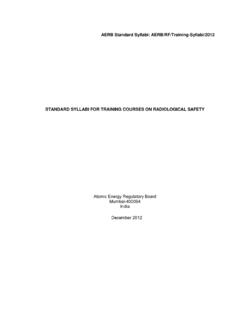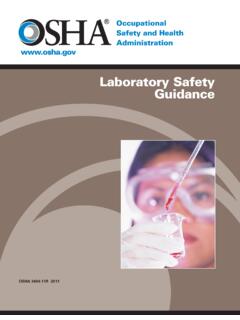Transcription of Radiation Safety Training Module: Diagnostic Radiology ...
1 Radiation Safety Training Module: Diagnostic RadiologyRadiation Protection in Diagnostic Radiology Radiological Safety DivisionAtomic Energy Regulatory BoardContent Mission of AERB ICRP-Principle for Radiological protection(Practice) Types of Radiation Generating Equipment: (RGE) Typical patient doses Radiation Protection for occupational workers Radiation Protection for patient ConclusionsMission of the (workers,publicandpatients)fromharmfulef fectsofionisingradiationwithoutundulylim itingtheuseoftechniquesthatmaycauseradia tionexposureINTERNATIONAL COMMISSION ON RADIOLOGICAL PROTECTION(ICRP) Radiation Safety PROGRAMME SHOULD BE DESIGNED TO :PREVENT DETRIMENTAL TISSUE REACTIONS (DETERMINISTIC EFFECTS)LIMIT or MINIMIZE THE PROBABILISTIC EFFECTS TO ACCEPETABLE LEVELS ICRP-Principle for RADIOLOGICAL PROTECTION JUSTIFICATION OPTIMISATION (ALARA ) DOSE LIMITATIONSN ever exceed Dose LimitsJUSTIFICATION The most common type of ionizing Radiation used in medicine all over the world are X-rays since its discovery.
2 There are obvious benefits from medical uses of X-rays , however there are well established health risks from Radiation if improperly applied. Hence every medical procedure involving Radiation needs to be justified. It is fact that Diagnostic x-ray examinations contribute the largest fraction to population dose from man made Radiation Alllivingthingsareexposedtoionisingradia tionfromthenatural(calledbackgroundradia tion)andmanmaderadiationsources Ionisingradiationmaycausebiologicalchang esintheexposedpersonhencethedosestotheoc cupationalworkersshallbekeptaslowasreaso nablyachievableanddosestopatientsshallbe optimized. LIMITSPart of the bodyOccupational ExposurePublic ExposureWhole body 20 mSv/year averaged over 1 mSv/y(Effective dose)5 consecutive years;30 mSv in any single year Lens of eyes 150 mSvin a year15 mSv/y(Equivalent dose)Skin 500 mSv in a year50 mSv/y(Equivalent dose)Extremities 500 mSv in a year-(Hands and Feet) Equivalent doseFor pregnant Radiation workers, after declaration of pregnancy 1 mSv on theembryo/fetus should not exceedTypes of Radiation Generating Equipment: (RGE) Computed Tomography Interventional Radiology Radiography (Fixed/Mobile) C-Arm/ O-Arm Mammography BMD Dental (Intraoral/OPG/CBCT)Note.
3 MRI and Sonography (Ultrasound) or non-ionising RGE do not come under purview of AERB regulations23 May 20179 Interventional RadiologyComputed TomographyRadiography /FluoroscopyDental-IOPAD ental OPG/CBCTBMDM ammographyC-ArmAverage Effective Dose (mSv) for Diagnostic Radiology procedurescf: Mettler et al. Radiology 2008, 248(1):254-263 ExamDose (mSv)Dental Background mSv/ yearComputed Tomography EquipmentPatient Effective Dose: 2-20 mSvInterventionalRadiology(Angiography& Angioplastyprocedures)Patient Effective Dose : 1to100 mSvGeneral RadiographyPatient Effective Dose : 1 mSvMammography Unit15/98 Patient Effective Dose : ~ mSvDental Radiography (IOPA)Patient Effective Dose : mSv17/98 Dual Emission X-ray Absorptiometry (DEXA)/ BMDP atient Effective Dose.
4 ~ Type ApprovalRadiation SafetyBuilt-in Safety (Design Safety ) Operational Safety Facility Proper planningTime -Distance -ShieldingProper Work Practice23-May-1718In this presentation we have considered only operational Safety componentsBuilt is Safety requirements are elaborated in separate presentation BasicFactorsforRadiationProtection Time Distance ShieldingI1 d12 = I2 d2 2 (INVERSE SQUARE LAW))To reduce the Radiation dose to the individual- Reduce the time spent near the X-ray source (reduce fluoroscopy procedure time) Increase the distance from the X-ray source Interpose a shielding material between X-ray source and Operator-(Use of Radiation protection accessories)23-May-1720 Operational SafetyComponents of operational Safety Handling of equipment by Qualified persons Use of protective accessories -Mobile Protective Barrier, Lead Apron, Organ shield etc.
5 Usage of Personnel monitoring devices (TLD) Preventive maintenance and periodic QA of equipment Updating with the current regulatory requirements21 Protection of Staff/OperatorUse protective devices! Advisable skirt type lead apron to distribute weight. use of lead apron ( mm lead equivalent), Radiation dose would be reduced by more than 90 % Use ceiling suspended screens, lateral shields and table curtains-must for interventional Radiology procedures. mm Lead Eqv. glass eyewear with side protection Ways to minimize Radiation exposure Alwayscollimatetotheareaofinterest,thela rgertheamountoftissuethebeamisallowedtoi rradiatethemorescatterradiationisproduce d. Avoidholdingofinfirmpatientbystaff,provi deprotectiveaprontotheattendantwhilehold ingsuchpatients. Alwaysoperatetheequipmentfrombehindthepr otectivebarrierorusingleadequivalentapro n.
6 Duringfluoroscopyexamsalwaysmakesurethat builtinsafetydevicessuchasflaps/ceilings uspendedglass/couchhangingflapsasapplica bleareavailableanduseitonroutinebasis. Duringuseofmobilex-rayequipmentstandatle ast6feetawayfromthepatientandwearleadapr on. Duringc-armproceduresstandingonthesideof theimageintensifierissafestbecausetherei smorescatterproducedattheentrancesurface sideofthepatient. DuringuseofPortableX-rayequipment, (whenX-raytubeisbelowthetable)hencecouch hangingleadequivalentrubberflapsshallbea lwaysused. Ingeneral, sEntranceSkinExposure. storage of Radiation protection devices-Lead apron23-May-1725 Personal Monitoring Badge (TLD) (Refer guidelines for proper use of TLD badges)WearTLDbadgeinsidetheLeadapronatc hestlevel RadiographyForR/ForinCathLab Oneinsidetheapronatchestlevel Additionalwristbadgeforproceduresrequiri nghandsclosetoprimarybeamAfterwork,store TLDbadgesinradiationfreeareaControlTLDC ardshouldbekeptawayfromradiationareaTLD below apronTLD above apronTLD23-May-1727 Radiation Protection Accessories Mobile Protective Barrier (MPB) mm Lead Eqv Lead Aprons mm Lead Eqv Thyroid Shield mm Lead Eqv Gonads mm Lead Eqv Eye Wear (Shield) mm Lead Eqv Rubber hanging Flaps (In IR ) mm Lead Eqv Hand Gloves mm Lead Eqv Lead Glass mm Lead Eqv Door (Lead Lined)
7 Mm Lead EqvRadiation Improvesimagingstandard IncreasetheLifeoftheX-raytube/equipmentb yavoidingretakes Usefulinreductionofunnecessarypatient sDose&hencedosetothestaff Agoodknowledgeofequipmentspecificationan dcharacteristicsisessentialforaneffectiv eoptimizationofradiationprotection (includingshieldingdevices) dose management Quality control protocols Justify the procedure Ask for records of previous Diagnostic procedures Plan the procedure (right patient, right contrast, purpose of scan/investigation) Know well about your equipment settings Ensure only qualified and trained operator should operate the equipment Inform patient about his/her procedure Handover procedure records (CD/disc and reports) including Radiation dose records to patient. Ensure that daily and periodic QA are performed and equipment performance is : Limiting the total beam on time Avoiding oblique lateral projections Prior to exposure,collimatethe x-ray beam to the area of interest , AVOID post exposure cropping of the image Selecting low dose rate protocol Use of correct exposure protocols for patient examinations including paediatric protocols MonitoringofDLPinCTandDAPvaluesforIRproc eduresand record-keepingofpatient film imaging Courtesy: UNNECESSARY DOSE TO PATIENTSUse Digital imaging correctly to reap its benefits !
8 ! Small conscious steps go a long way in optimizing doses to exposures are obviousOver exposures remain unnoticed Best quality image is not normally necessary for required field should be always collimated to the area of interestBucky/grid should be used ,alwaysuseadditionalshields, protection of paediatricpatientsWhy are children receiving higher doses? Using unsuitable Automatic Exposure systems; in imported equipment, which are not customized to Indian demography before use. Following adult exposure protocols for children Expecting best quality images, even if there is no additional gain in terms of diagnosis Not using dose-minimisingfeatures that machine provides. Radiographs taken by unqualified personnel, who do not fully appreciate the implication of their actions.
9 Not considering alternate means of diagnosis (MRI, USG etc). Not asking for previous x-ray records, for the same ailment. Grid should not normally be used Use equipment with high power higher mA and shortest time Ensure that for AEC systems, protocols are customized to Indian child. Use thyroid, gonad shields & immobilization devicesAVOID BABYGRAMS !!!EXPOSE ONLY AREA OF INTERESTR adiation protection of paediatricpatientsKeep in mind for Child considerations for Computed Tomography and Interventional Radiology Ifpatientdosesarehigherthantheexpectedle vel,butnothighenoughtoproduceobvioussign sofradiationinjury,theproblemmaygoundete ctedandunreported,puttingpatientsatincre asedriskforlong-termradiationeffects. EveryfacilityperformingCTimagingshouldpe riodicallyreviewitsCTprotocolsandbeaware ofthedoseindices(suchasCTDI,DLP)Major reasons in increasing dose Image quality higher than necessary examinations, using the features that the machine provides for dose reductionPediatric CT 30% to 40% of CT exams can be managed with alternate modalities (egUSG,MRI etc.)
10 Overuse of multiphase exams in pediatricpractice. Paediatric exams typically use kVpvalues that are too high Same exposure factors used for children as for adult Same exposure factors for pelvic (high contrast region) as for abdomen (low contrast region)Image gently Child size the amount of Radiation used Scan only when necessary Scan only the indicated region Scan once; multiphase scanning is usually not necessary for childrenAutomatic Exposure Control Dose increases if one does not select factors properly Noise index or image quality parameter If one selects High noise index-poor image quality, low dose Low noise index-good quality, high dose Example: Kidney for stones: unlikely to be missed even in low dose scan, but for appendicitis-higher dose scan is needed Heavy patient-upper value may reach41 Interventional RadiologyCTRadiographyInterventional Radiology -History Minimallyinvasivefluoroscopicallyguidedp rocedures ,MD Interventionalradiologist NobelPrizeinMedicinein1978.














